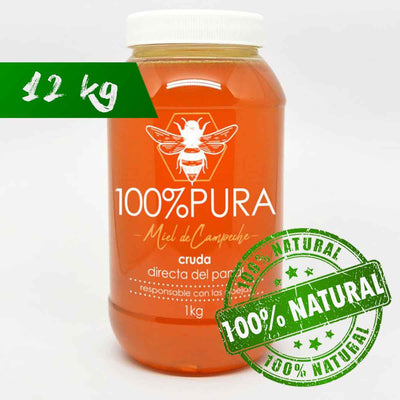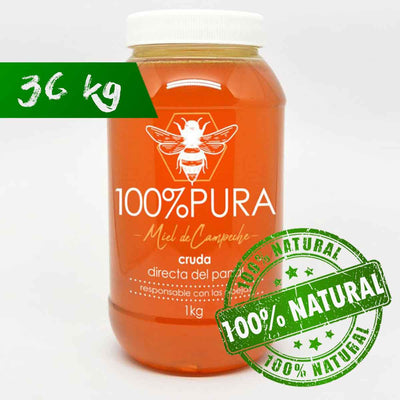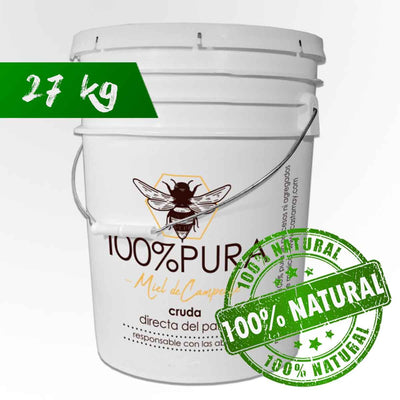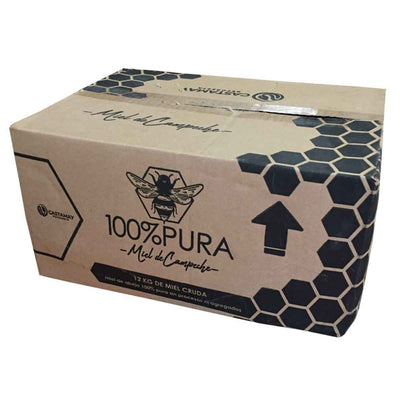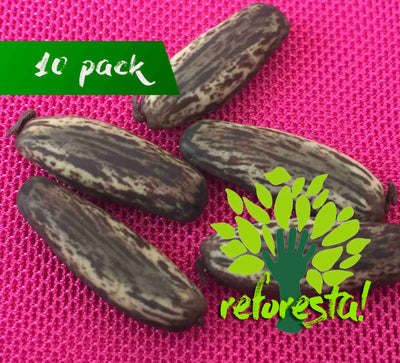What are the health benefits of raw honey?
People have used raw honey in traditional medicine for hundreds of years. This sweet and natural substance can contain healthy elements that processed honey does not have.
Honey provides a variety of health benefits. Raw honey, which comes directly from the hive, contains healthy bee pollen and propolis and many antioxidants.
Raw honey has not been confirmed to have more health benefits than regular honey, but some people believe that the processing and pasteurization that regular honey undergoes diminishes many of the beneficial elements, and that raw honey provides more benefits for health than honey that has been processed.
What is raw honey?
Raw honey is not filtered or pasteurized.
Honey is a sweet, golden liquid made by bees, which store their honey in small hexagonal cups called a honeycomb. Raw honey comes directly from the honeycomb.
The honey from the hive contains bee pollen, beeswax, and parts of dead bees. Honey manufacturers generally pass raw honey through a filter to remove as many impurities as possible.
Unlike raw honey, regular honey undergoes a pasteurization process. This means that manufacturers have heated it to kill yeast cells that can affect its taste, increase its shelf life, and make it look more transparent and attractive. However, pasteurization can negatively affect the amount of nutrients in honey.
Some historical evidence estimates that humans have used honey for more than 8,000 years. During ancient times, people would have used raw honey, but today, most people use pasteurized honey.
Honey naturally offers the following healthy properties:
• Antibacterial action
• Provides wound healing effects
• High content of antioxidants
• Has anti-inflammatory effects
Raw honey also contains bee pollen and propolis, which is a sticky substance, similar to the glue that bees use to hold their hive together. Pasteurized honey may not contain the same levels of propolis and bee pollen as raw honey.
Research carried out in 2017 on raw honey, and the content of pollen and propolis, suggests that these elements may offer anti-inflammatory, antioxidant, antibacterial and anticancer properties.
Seven health benefits based on the latest research on raw honey:
1. Antioxidant effects
Researchers believe that some of the main health benefits of raw honey come from its high antioxidant content. Natural honey contains a range of compounds that act as antioxidants, including phytochemicals, flavonoids, and ascorbic acid.
Antioxidants reduce the oxidative state in the body by eliminating free radicals. Scientists have linked the oxidative state to a variety of chronic health conditions, including many types of cancer. By eating a diet rich in antioxidants, people can reduce the risk of chronic diseases.
Some people believe that pasteurization reduces the amount of antioxidants in honey, which means that pasteurized honey may not offer the same benefits as raw honey. There is no specific research on how pasteurization affects the antioxidants in honey, but studies show that heating other foods can reduce their antioxidant content.
2. Nutrition
Honey contains specific nutrients that can contribute healthy elements to the diet.
The exact nutritional contents and chemical composition of raw honey vary between different countries and environments; and they depend in part on the type of flowers from which bees collect nectar.
One tablespoon or 21 grams (g) of raw honey contains 64 calories and 16 grams of sugar. These values can vary between brands and lots.
Natural honey naturally contains small amounts of the following vitamins and minerals:
• Niacin
• Riboflavin
• Pantotheic Acid
• Calcium
• Magnesium
• Manganese
• Potassium
• Match
• Zinc
Honey naturally contains sugar, slightly more than half of the sugar in honey is fructose. Research has linked fructose to a number of health problems, but even with its fructose content, honey may be a healthier option than table sugar. Some research suggests that honey may offer a protective effect against diabetes, and some types of honey can help improve cholesterol levels.
People who have diabetes or who follow diets restricted in sugar, can choose to eat honey in moderation to avoid significant changes in their blood glucose levels. Pure honey has a glyceride index (GI) of 58, which means that it has a medium effect on blood glucose levels.
3. Antibacterial action
Honey is a natural antibacterial and antimicrobial agent. It contains hydrogen peroxide and glucose oxidase, and has a low pH level, which means it can kill harmful bacteria and fungi. In addition, due to its atomic chemical composition, it prevents yeast and bacteria from growing.
Due to its antibacterial action, people can use it to clean wounds. Research has shown that raw honey can kill common pathogens including:
• Escherichia coli or E. coli, a bacteria that causes food poisoning and wound infections.
• Staphylococcus aureus or S. aureus, a microbe that causes skin infections.
• Helicobacter pylori or H. pylori, a bacterium that causes stomach ulcers and chronic gastritis.
4. Wound healing
Numerous studies have suggested that honey works well as a wound dressing.
Various studies claim that honey is useful in wound healing due to its antibacterial, anti-inflammatory and antioxidant properties. Some evidence also suggests that honey has antiviral and antifungal properties.
Additionally, honey is acidic, which helps to release oxygen from the wound and promotes healing.
Raw honey is applied directly to minor cuts and burns, then place gauze or bandage over the wound.
5. Relieve cough
Studies have suggested that honey may be as or more effective than some over-the-counter cough medicines. Many cough medicines are not safe for younger children, so honey can be a good alternative for children older than one year.
Raw honey can provide an effective way to decrease the severity and frequency of nighttime coughs in children and adults. A small-scale study found that a mixture of raw milk and honey relieved children's coughs as effectively as an over-the-counter medicine.
To relieve a cough, take a teaspoon of raw honey and avoid other liquids or foods afterwards, to allow the honey to cover the throat.
6. Treatment of diarrhea
Raw honey can have a calming effect on digestion, helping with diarrhea symptoms.
A study of 150 children with acute gastroenteritis found that those who received raw honey with an oral rehydration solution had a better recovery from diarrhea than those who did not receive honey. The children who received honey had fewer bowel movements and recovered faster from the disease.
To help treat mild diarrhea, try taking a teaspoon of raw honey or mixing honey with a drink. Avoid taking too much honey because too much sugar can make diarrhea worse.
7. Protecting the brain
Some evidence suggests that honey may have antioxidant and anti-inflammatory powers that may benefit the brain. An animal study found that rats that consumed raw honey had protection against brain damage caused by exposure to lead.
Other studies established that raw honey may contain ingredients that help fight inflammation in the hippocampus, a part of the brain involved in memory.
Risks
As long as a person is not allergic to bee pollen, raw honey is generally safe to use.
The Centers for Disease Control and Protection (CDC) generally warns that people should not give honey to babies younger than 1 year due to the risk of infant botulism. Honey is safe from 1 year onwards. This applies to both raw and regular honey.
Choosing the right kind of honey
Raw honey must have a label that says "raw honey." If the label does not include the word "raw", or does not come directly from a farmer or beekeeper who can confirm that the product is raw, the manufacturer has probably pasteurized it.
The label can also describe the type of flowers that the bees pollinated to make that honey. The type of flower determines the taste, color, and antioxidant and vitamin content of honey.
Many types of pasteurized honey have labels that say "pure honey." Others may say "clover honey" or they may say they come from a local area. Even products labeled "organic honey" may not be raw, as some manufacturers pasteurize organic honey.
Some processed honey products contain corn syrup, high fructose or other additives. Check the label to make sure the honey is pure.
Raw honey has become more popular in recent years, and people can now buy it in many supermarkets and health food stores. Farmers markets also sell raw honey, sometimes directly from the beekeeper.
Online stores offer a wide range of raw honey and regular honey brands.
When raw honey turns into "sugar or crystallizes"
Raw honey can crystallize after a few months of storage. This means that honey takes on a grainy or sugar-like texture. Crystallized honey is safe to eat and tastes the same.
To make the honey runny again, use a gentle heating technique:
1 Boil a pot of water and remove it from the heat.
2 Place the honey bowl in the hot water. Do not allow the water to reach the top of the honey container to avoid contaminating it.
3 Remove the honey container after a few minutes. If it is still solid or crystallized, repeat the process.
Do not microwave raw honey or put it directly into boiling water or on a hot stove, as this can destroy some of its nutrients

